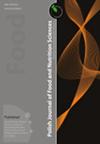Cricket Flour and Pullulan Microparticle Formation via Electro-Blow Spinning as a New Method for the Protection of Antioxidant Compounds from Fruit Extracts
IF 2.3
4区 农林科学
Q3 FOOD SCIENCE & TECHNOLOGY
引用次数: 0
Abstract
Cricket flour was evaluated as an encapsulation material for protecting phenolic-rich fruit extracts (cranberry fruit and po-megranate peel extracts) and compared to pullulan. Electro-blow spinning (EBS) was used as a high throughput technique for encapsulation and compared to freeze-drying. The particles’ morphology was analyzed via scanning electron microscopy (SEM). Fourier transform infrared and UV-vis spectroscopy were used for chemical characterization and encapsulation efficiency determination, respectively. The extract stability and antioxidant activity of the microparticles were studied by exposing samples to UV light irradiation for 30 h. Both extracts were successfully encapsulated in all encapsulating materials. SEM analysis showed that the obtained materials were micro-sized with a shape of capsule. Encapsulation efficiency was between 58.5 and 88.1% for the samples made via EBS and 51.2 to 79.3% for those made via freeze-drying. Encapsulation brought a significant improvement of extract stability and antioxidant activity. The non-protected extracts lost 50% of their antioxidant activity after 30 h of UV light radiation, while those protected with pullulan and cricket flour filtrate mixture experienced a 20% activity reduction. These findings indicate EBS to be a successful technique for the encapsulation of bio-active molecules, and cricket flour to be a new potential encapsulating material candidate that proves best when using a copolymer, such as pullulan.通过电流纺丝形成蟋蟀粉和普鲁兰微粒作为保护水果提取物中抗氧化化合物的新方法
对蟋蟀粉作为保护富含酚的水果提取物(蔓越莓和石榴皮提取物)的包封材料进行了评价,并与普鲁兰进行了比较。采用电吹纺丝(EBS)作为高通量的封装技术,并与冷冻干燥进行了比较。通过扫描电子显微镜(SEM)分析了颗粒的形貌。傅里叶变换红外光谱和紫外可见光谱分别对其进行了化学表征和包封效率的测定。通过紫外光照射30 h,研究了提取液的稳定性和抗氧化活性。两种提取液均成功地包封在所有包封材料中。SEM分析表明,所制得的材料为微尺寸,呈胶囊状。EBS法和冷冻干燥法的包封率分别为58.5 ~ 88.1%和51.2 ~ 79.3%。包封显著提高了提取物的稳定性和抗氧化活性。在紫外线照射30小时后,未受保护的提取物的抗氧化活性降低了50%,而受普鲁兰和蟋蟀粉滤液混合物保护的提取物的抗氧化活性降低了20%。这些发现表明,EBS是一种成功的包封生物活性分子的技术,而蟋蟀粉是一种新的潜在的包封材料候选材料,当使用共聚物时,如普鲁兰被证明是最好的。
本文章由计算机程序翻译,如有差异,请以英文原文为准。
求助全文
约1分钟内获得全文
求助全文
来源期刊

Polish Journal of Food and Nutrition Sciences
FOOD SCIENCE & TECHNOLOGY-
CiteScore
4.30
自引率
12.50%
发文量
25
审稿时长
20 weeks
期刊介绍:
The Polish Journal of Food and Nutrition Sciences publishes original, basic and applied papers, reviews and short communications on fundamental and applied food research in the following Sections:
-Food Technology:
Innovative technology of food development including biotechnological and microbiological aspects
Effects of processing on food composition and nutritional value
-Food Chemistry:
Bioactive constituents of foods
Chemistry relating to major and minor components of food
Analytical methods
-Food Quality and Functionality:
Sensory methodologies
Functional properties of food
Food physics
Quality, storage and safety of food
-Nutritional Research Section:
Nutritional studies relating to major and minor components of food (excluding works related to questionnaire
surveys)
-“News” section:
Announcements of congresses
Miscellanea
 求助内容:
求助内容: 应助结果提醒方式:
应助结果提醒方式:


